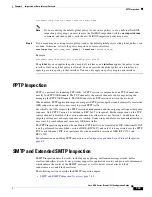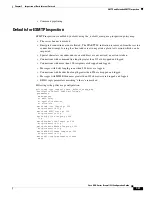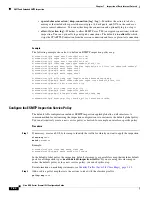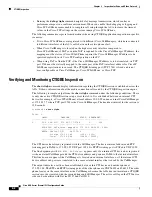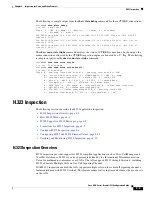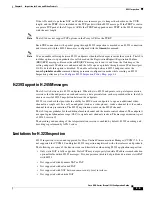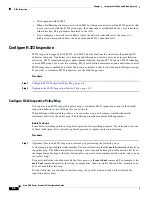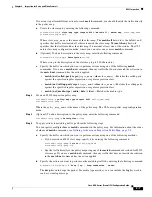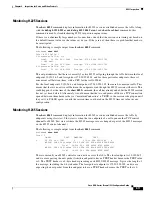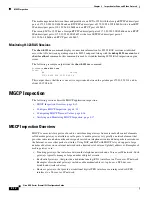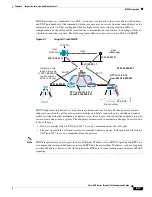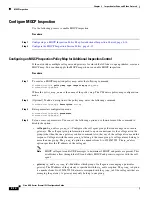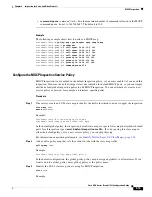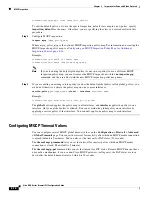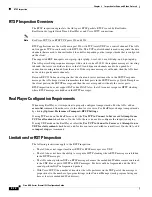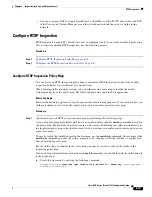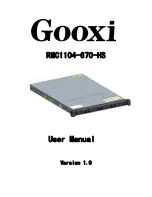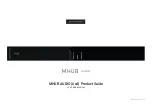
8-4
Cisco ASA Series Firewall CLI Configuration Guide
Chapter 8 Inspection for Voice and Video Protocols
H.323 Inspection
The two major functions of H.323 inspection are as follows:
•
NAT the necessary embedded IPv4 addresses in the H.225 and H.245 messages. Because H.323
messages are encoded in PER encoding format, the ASA uses
an ASN.1 decoder to decode the
H.323 messages.
•
Dynamically allocate the negotiated H.245 and RTP/RTCP connections. The H.225 connection can
also be dynamically allocated when using RAS.
How H.323 Works
The H.323 collection of protocols collectively may use up to two TCP connection and four to eight UDP
connections. FastConnect uses only one TCP connection, and RAS uses a single UDP connection for
registration, admissions, and status.
An H.323 client can initially establish a TCP connection to an H.323 server using TCP port 1720 to
request Q.931 call setup. As part of the call setup process, the H.323 terminal supplies a port number to
the client to use for an H.245 TCP connection. In environments where H.323 gatekeeper is in use, the
initial packet is transmitted using UDP.
H.323 inspection monitors the Q.931 TCP connection to determine the H.245 port number. If the H.323
terminals are not using FastConnect, the ASA dynamically allocates the H.245 connection based on the
inspection of the H.225 messages.
Note
The H.225 connection can also be dynamically allocated when using RAS.
Within each H.245 message, the H.323 endpoints exchange port numbers that are used for subsequent
UDP data streams. H.323 inspection inspects the H.245 messages to identify these ports and dynamically
creates connections for the media exchange. RTP uses the negotiated port number, while RTCP uses the
next higher port number.
The H.323 control channel handles H.225 and H.245 and H.323 RAS. H.323 inspection uses the
following ports.
•
1718—Gate Keeper Discovery UDP port
•
1719—RAS UDP port
•
1720—TCP Control Port
You must permit traffic for the well-known H.323 port 1719 for RAS signaling. Additionally, you must
permit traffic for the well-known H.323 port 1720 for the H.225 call signaling; however, the H.245
signaling ports are negotiated between the endpoints in the H.225 signaling. When an H.323 gatekeeper
is used, the ASA opens an H.225 connection based on inspection of the ACF and RCF messages.
After inspecting the H.225 messages, the ASA opens the H.245 channel and then inspects traffic sent
over the H.245 channel as well. All H.245 messages passing through the ASA undergo H.245 application
inspection, which translates embedded IP addresses and opens the media channels negotiated in H.245
messages.
The H.323 ITU standard requires that a TPKT header, defining the length of the message, precede the
H.225 and H.245, before being passed on to the reliable connection. Because the TPKT header does not
necessarily need to be sent in the same TCP packet as H.225 and H.245 messages, the ASA must
remember the TPKT length to process and decode the messages properly. For each connection, the ASA
keeps a record that contains the TPKT length for the next expected message.
Содержание ASA 5512-X
Страница 5: ...P A R T 1 Service Policies and Access Control ...
Страница 6: ......
Страница 50: ...3 14 Cisco ASA Series Firewall CLI Configuration Guide Chapter 3 Access Rules History for Access Rules ...
Страница 51: ...P A R T 2 Network Address Translation ...
Страница 52: ......
Страница 126: ...5 28 Cisco ASA Series Firewall CLI Configuration Guide Chapter 5 NAT Examples and Reference DNS and NAT ...
Страница 127: ...P A R T 3 Application Inspection ...
Страница 128: ......
Страница 255: ...P A R T 4 Connection Settings and Quality of Service ...
Страница 256: ......
Страница 288: ...12 14 Cisco ASA Series Firewall CLI Configuration Guide Chapter 12 Quality of Service History for QoS ...
Страница 303: ...P A R T 5 Advanced Network Protection ...
Страница 304: ......
Страница 339: ...P A R T 6 ASA Modules ...
Страница 340: ......
Страница 398: ...17 28 Cisco ASA Series Firewall CLI Configuration Guide Chapter 17 ASA CX Module History for the ASA CX Module ...




